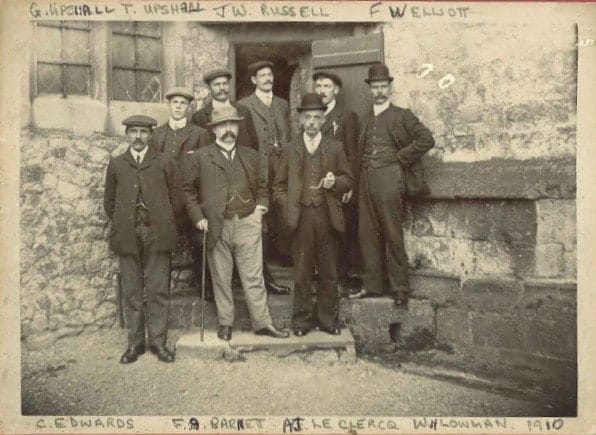
In 2010 David Underdown begin to research the 152 men named on the Surrey Association’s of Church Bell Ringers Roll of Honour for the First World War.
John William Russell was one of the most interesting of these names. The following is taken from an article that appeared in The Ringing World on 19 October 2012, pp1102–1104, 1106–1107, and was reproduced on the website “Innovating in Combat” on 22nd January 2014.
We are grateful to David for letting us publish excerpts of the article below.
“In terms of his war service, perhaps the most interesting of them is the man who appears on the roll as J Russel of Dorking, but various clues soon led me to realise that he was in fact John William Russell. A simple gardener before the war: he would end it a lieutenant and holding one of the nation’s second highest awards for gallantry, the Distinguished Conduct Medal; two of the third highest decorations, both the Military Cross and the Military Medal; and was also Mentioned in Despatches. He served throughout with the Signal Service of the Royal Engineers.
John William Russell was born at Mickleham, Surrey, on 10 August 1887. The family must have moved to Ewhurst quite soon after, by 1891 they were living there, at Coneyhurst Lodge, and the census lists his 2-year-old sister, Catherine Annie as having been born in Ewhurst. His parents were John (28 – a gardener, born Tydd St Mary, Lincs) and Catherine (29, born Elgin, Scotland), John William often appears in ringing records as W Russell, suggesting he may have been known as William, so Catherine Annie may likewise have been known as Annie. He was educated at Ewhurst National School, but by the time of the 1901 census, he was 13 and working as a garden boy. By then the family had grown further, to include Ruth (9), Caroline Jane (7), Charlie (6) and Jessie (5).”
John Russell worked in Farnham, Surrey from 1908 to 1912. His local connection continues below.
“It appears that Russell moved back to Surrey sometime in 1912, probably to work in Abinger. One of the referees on his application for a wartime commission was Lady Mirrielees, who lived at Pasture Wood, Abinger. The membership records of the Ancient Society of College Youths record that John William Russell of Abinger was elected a member in 1912. He visited old haunts at the end of August, finally scoring a peal at Bentley. On 6 November he rang in a College Youths’ peal of Stedman Triples at Ashtead, Surrey (his first of Stedman); on 19 December he rang a peal of Grandsire Triples at Dorking, this commemorated the laying of the foundation stone for a new chapel. This chapel seems to have proceeded rapidly; on 14 March 1913 there was another peal of Grandsire Triples to celebrate its dedication. “
“Russell joined the Royal Engineers at Aldershot on 11 September 1914, just over a month after the outbreak of war. He had been medically examined two days previously, reverting to his correct age, given as 27 years and 1 month. The medical officer described him as being 5’8¼” – relatively tall for the time, having a 36” chest and weighing 156 lbs, with dark hair, a fresh complexion and blue eyes. When signing up, he described himself as a fitter, rather than a gardener, but this seems to have been another attempt to improve his chances, there is no sign in his papers that he was given a trade test, and he was given the rank of pioneer initially, indicating that the army did not view him as a skilled tradesman.”
In 1915 he married Rosetta Pickard in Tilehurst near Reading. Rosetta died in 1926.
He fought on the Western Front for the whole of the war, apart from spells away from the trenches with injuries. He was awarded the Military Medal during his time at Arras.
On 12 May 1922 he relinquished his commission.
“Russell died, sadly, on Christmas Day 1946, aged 59. The causes of death are given as (a) cerebral embolism and (b) mitral disease [of the heart]. Olive was present at the death, which took place at Grange Estate, St Leonard’s and St Ives Rural District (near Ringwood). His occupation is recorded as “Contractors’ Foreman (Engineer)”. He was buried at Ringwood Cemetery on 28 December 1946 in grave D/D 249. The burial records describe him as “Clerk of Works, retired”.”
To read the full article visit the Innovating in Combat website.
Many thanks to David Underdown for allowing us to publish excerpts from this article.

